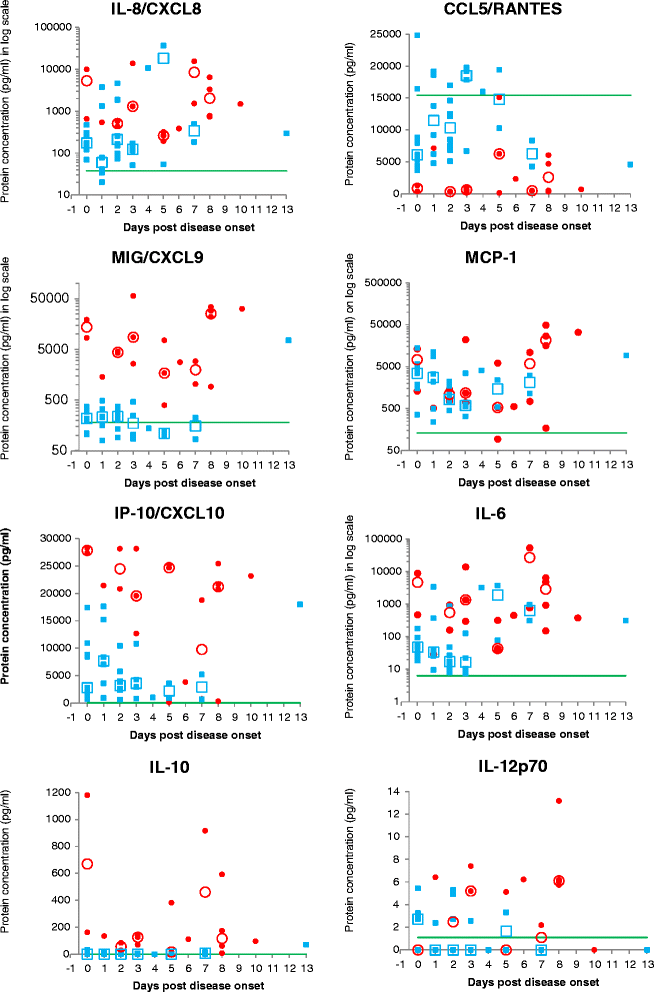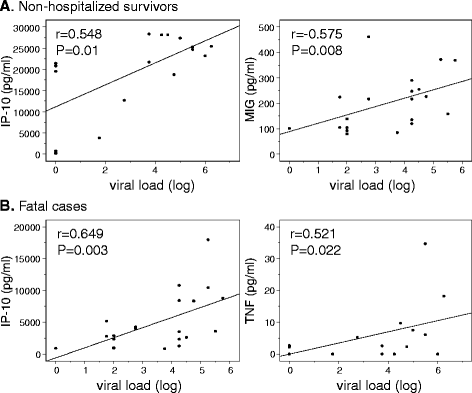Serum levels of inflammatory cytokines in Rift Valley fever patients are indicative of severe disease
- PMID: 26437779
- PMCID: PMC4595326
- DOI: 10.1186/s12985-015-0392-3
Serum levels of inflammatory cytokines in Rift Valley fever patients are indicative of severe disease
Abstract
Background: Rift Valley fever (RVF) is a mosquito-borne viral zoonosis affecting domestic and wild ruminants, camels and humans. Outbreaks of RVF are characterized by a sudden onset of abortions and high mortality amongst domestic ruminants. Humans develop disease ranging from a mild flu-like illness to more severe complications including hemorrhagic syndrome, ocular and neurological lesions and death. During the RVF outbreak in South Africa in 2010/11, a total of 278 human cases were laboratory confirmed, including 25 deaths. The role of the host inflammatory response to RVF pathogenesis is not completely understood.
Methods: Virus load in serum from human fatal and non-fatal cases was determined by standard tissue culture infective dose 50 (TCID50) titration on Vero cells. Patient serum concentration of chemokines and cytokines involved in inflammatory responses (IL-8, RANTES, CXCL9, MCP-1, IP-10, IL-1β, IL-6, IL-10, TNF and IL-12p70) was determined using cytometric bead assays and flow cytometry.
Results: Fatal cases had a 1-log10 higher TCID50/ml serum concentration of RVF virus (RVFV) than survivors (p < 0.05). There were no significant sequence differences between isolates recovered from fatal and non-fatal cases. Chemokines and pro- and anti-inflammatory cytokines were detected at significantly increased (IL-8, CXCL9, MCP-1, IP-10, IL-10) or decreased (RANTES) levels when comparing fatal cases to infected survivors and uninfected controls, or when comparing combined infected patients to uninfected controls.
Conclusions: The results suggest that regulation of the host inflammatory responses plays an important role in the outcome of RVFV infection in humans. Dysregulation of the inflammatory response contributes to a fatal outcome. The cytokines and chemokines identified in this study that correlate with fatal outcomes warrant further investigation as markers for disease severity.
Figures




References
-
- Swanepoel R, Coetzer JA. Rift Valley fever. In: Coetzer JA, Tustin RC, editors. Infectious Diseases of Livestock. Cape Town: Oxford University Press Southern Africa; 2004. pp. 1037–70.
Publication types
MeSH terms
Substances
LinkOut - more resources
Full Text Sources
Other Literature Sources
Molecular Biology Databases
Research Materials
Miscellaneous

